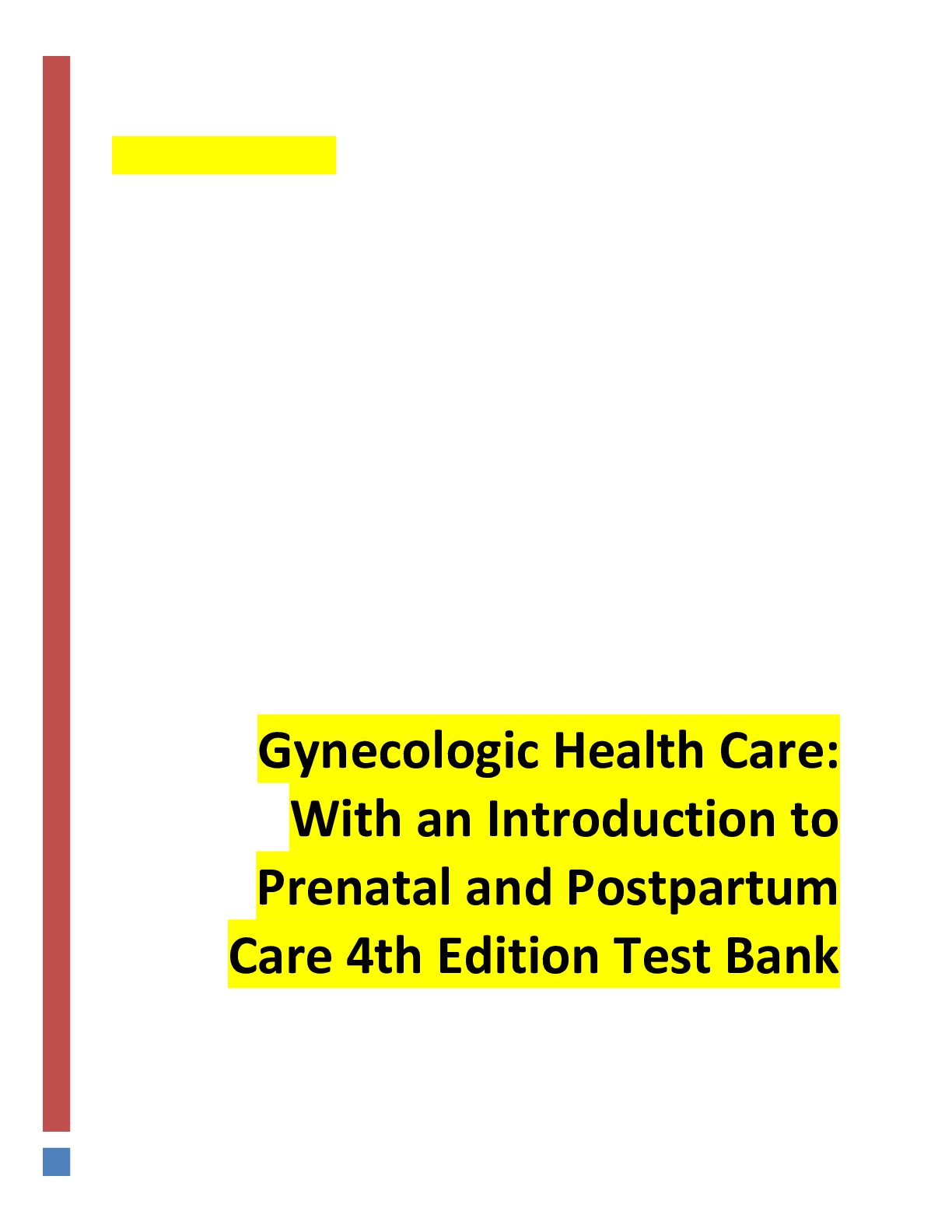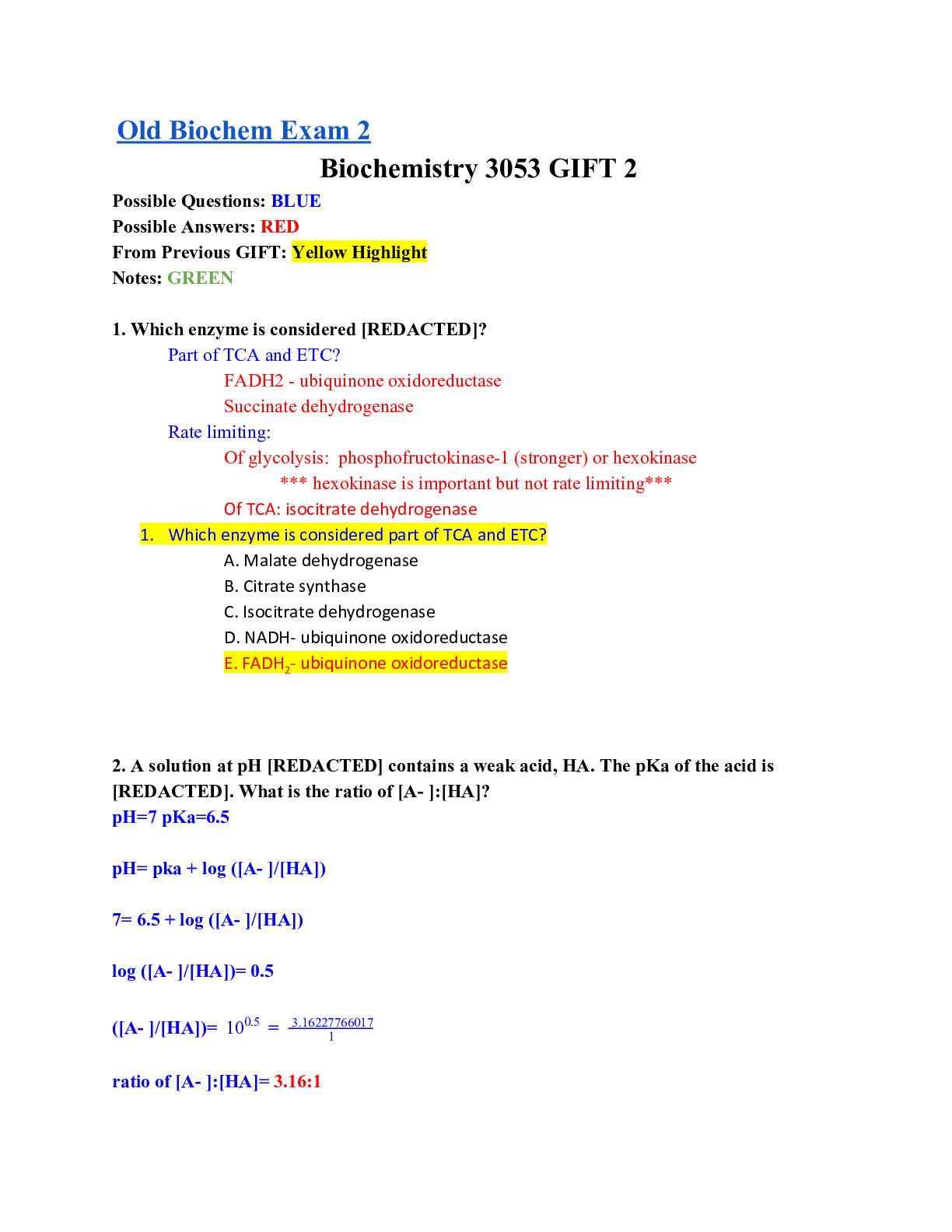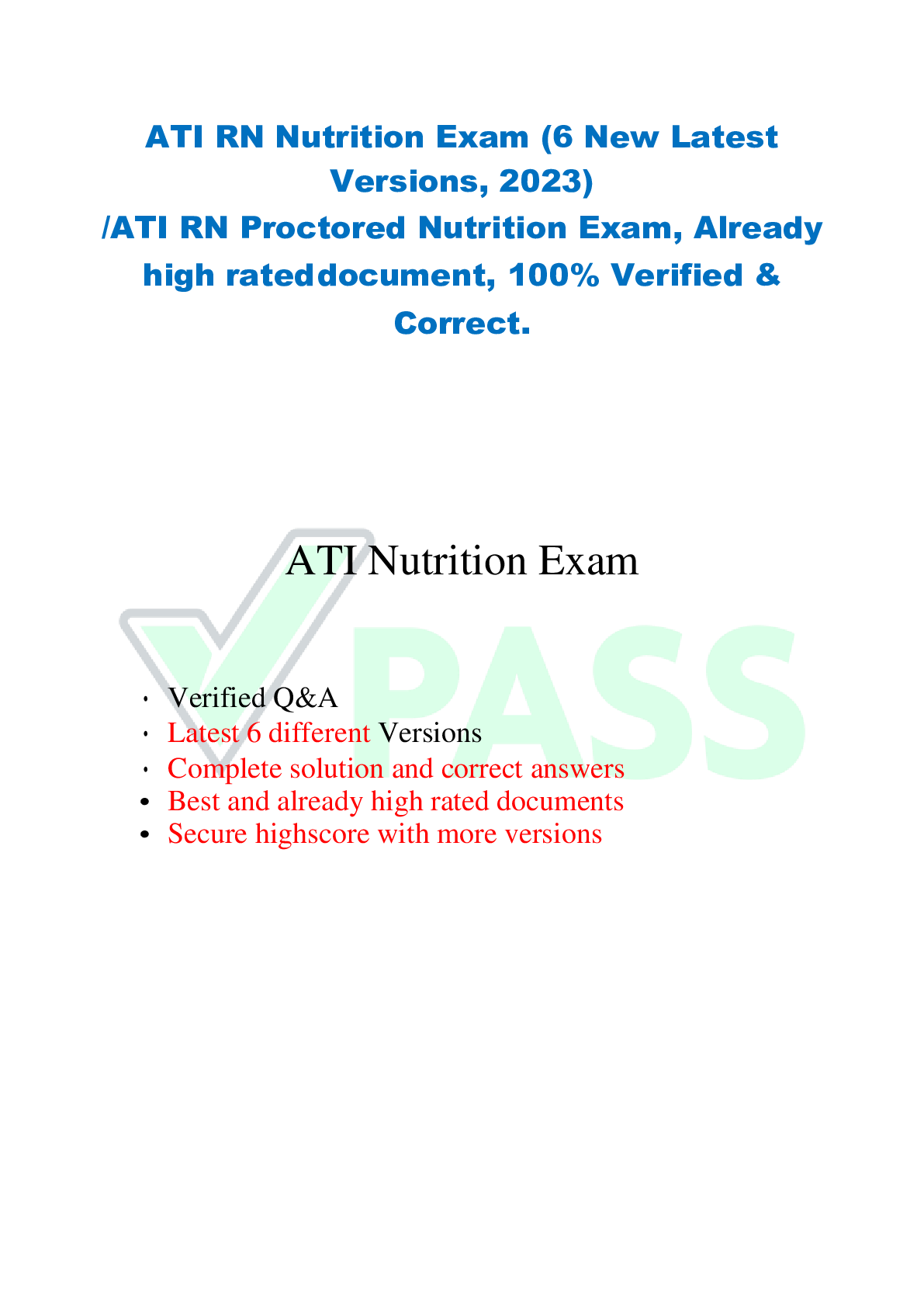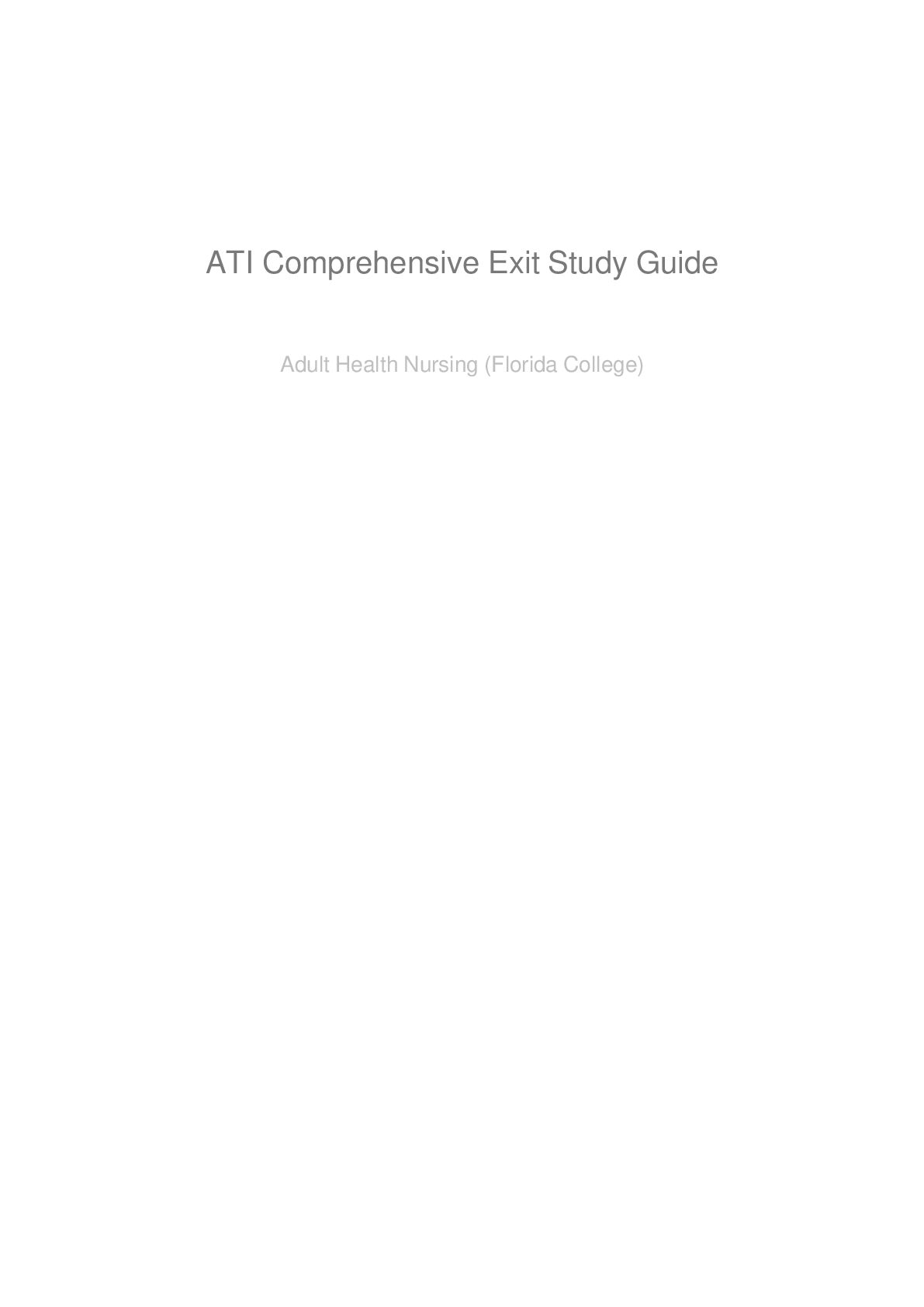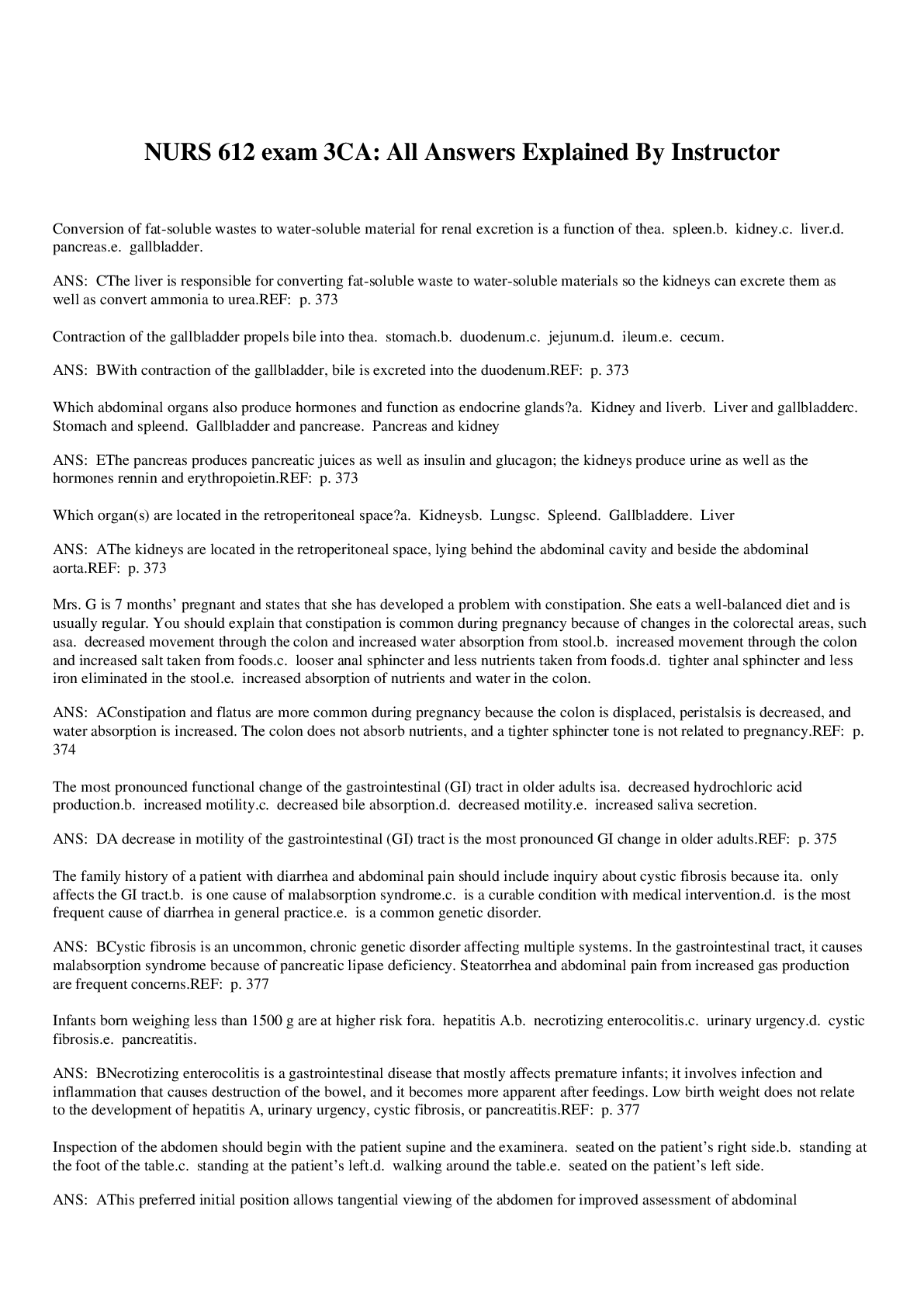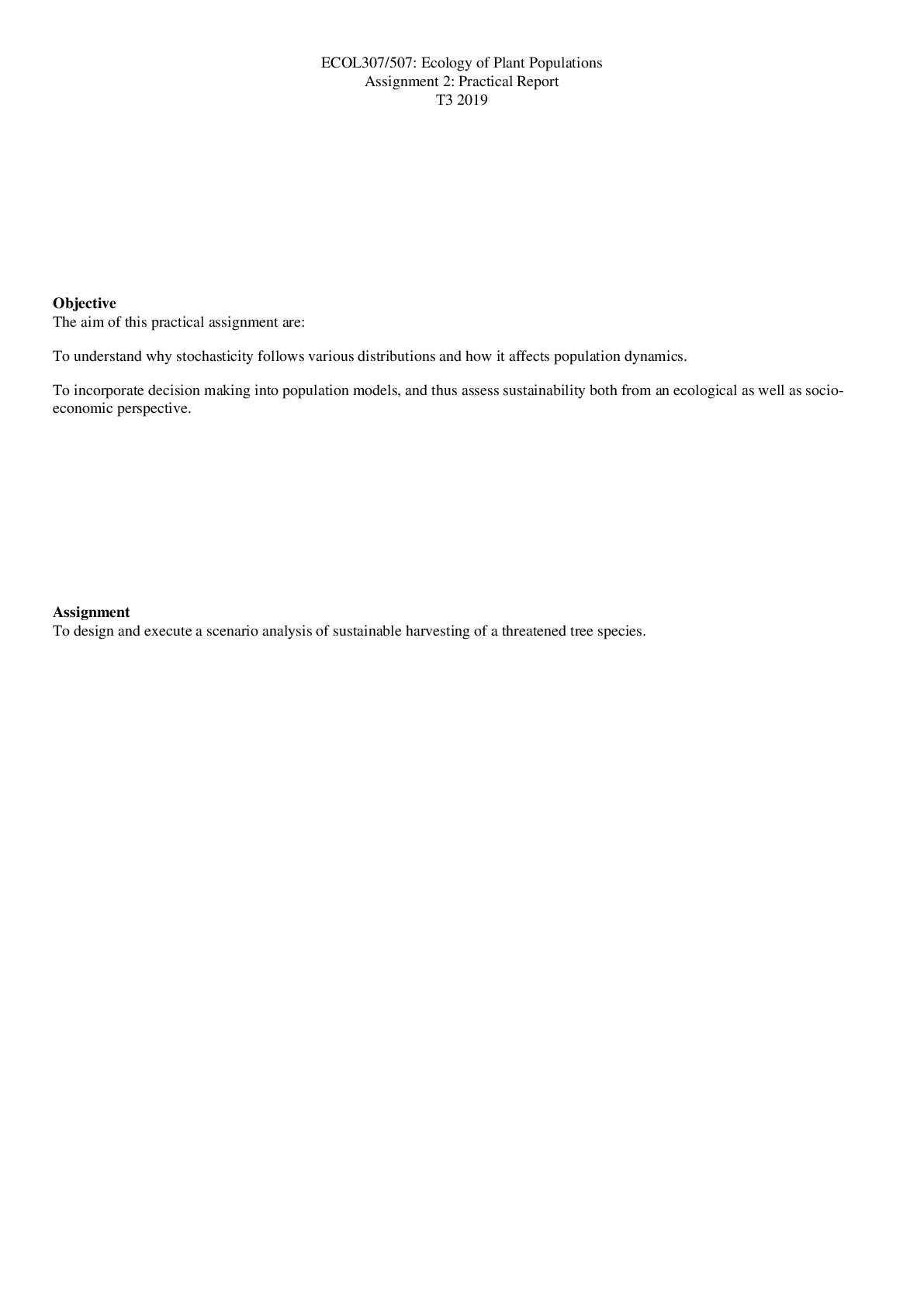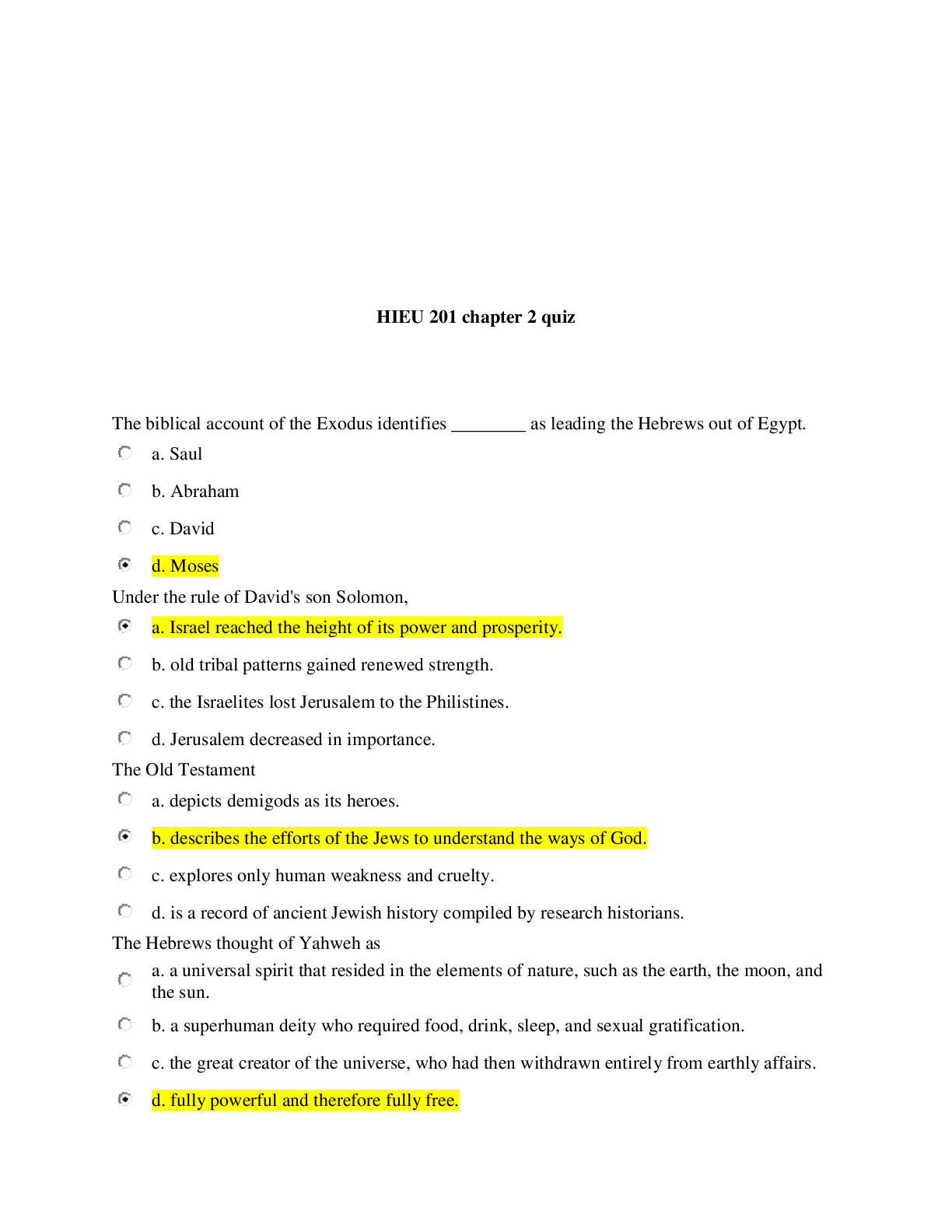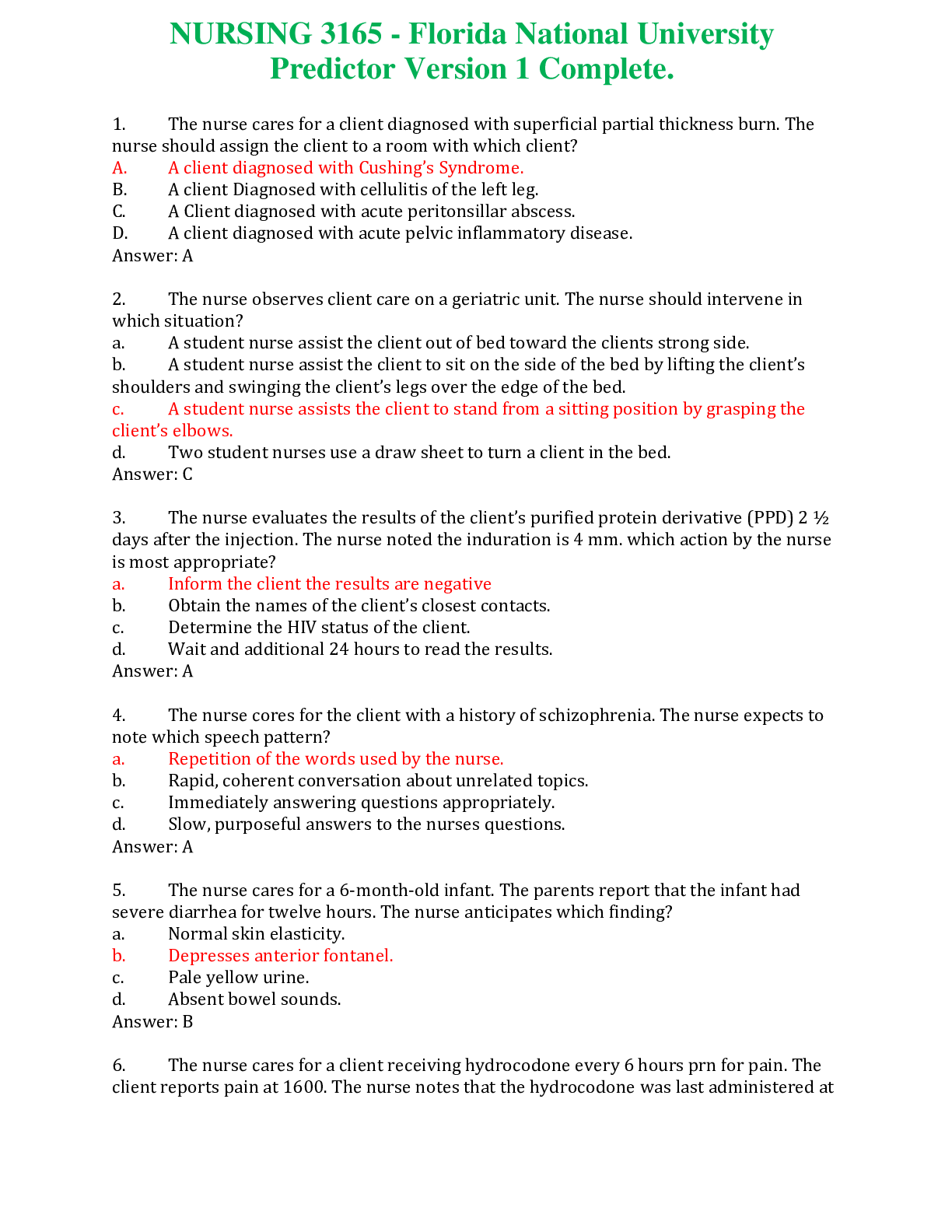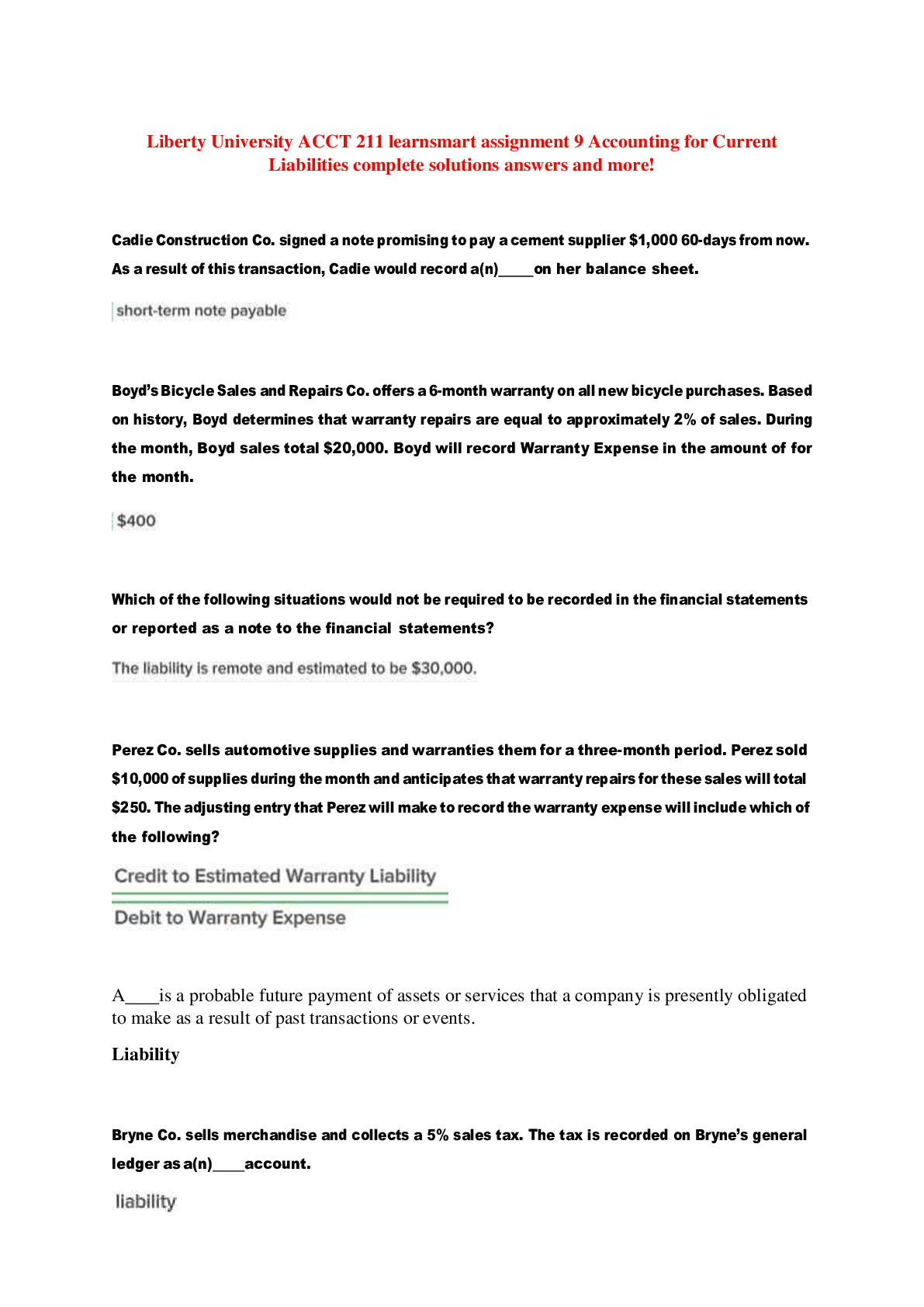*NURSING > QUESTIONS & ANSWERS > Stuvia-909199-ati-fundamentals-proctored-exam-questions-and-answers-with-rationales-latest-2020-2021 (All)
Stuvia-909199-ati-fundamentals-proctored-exam-questions-and-answers-with-rationales-latest-2020-2021
Document Content and Description Below
ctivity C. Cleaning windows -incorrect: Cleaning windows is a moderate-intensity activity D. Washing dishes -Washing dishes requires a low level of activity and is appropriate for this client. 16... . A nurse is caring for a client who is receiving dextrose 5% in water IV at 150 mL/hr and has ingested 4 oz of water and ½ pint of milk. What is the total 8-hr fluid intake in milliliters that the nurse should document for this client? (round to nearest whole number) -1560 17. A nurse is performing a physical examination of a client. The nurse should use percussion to evaluate which of the following parts of the client’s body? A. Heart -incorrect: The nurse uses inspection, palpation, and auscultation to evaluate the heart. B. Lungs -Percussion creates a vibration that helps the examiner determine the density of the underlying tissue. The lungs are hollow organs that can produce sounds such as resonance (a hollow sound over alveoli) or dullness (a dull sound over consolidated areas of the lungs or diaphragm). The nurse also uses auscultation and palpation when evaluating the lungs. C. Thyroid gland -incorrect: The nurse uses inspection and palpation to evaluate the thyroid gland. D. Skin -incorrect: The nurse uses inspection and palpation to evaluate the skin. 18. A nurse is supervising a newly licensed nurse who is administering a controlled substance. Which of the following actions by the newly licensed nurse indicates an understanding of the procedure? A. Placing an unused portion of the medication in a sharps box -incorrect: The nurse should not dispose of an unused portion of a controlled substance in the sharps container because this action does not maintain safe control of the narcotic. B. Asking another nurse to observe the disposal of an unused portion of the medication Downloaded by: franklinalvarez16 | [email protected] Distribution of this document is illegal Stuvia.com - The Marketplace to Buy and Sell your Study Material -The nurse should ask another nurse to witness the disposal of a controlled substance to maintain safe control of the narcotic. C. Counting the inventory of the available narcotic after administering the medication -incorrect: The nurse should count the inventory of the controlled substance before removing a dosage to maintain safe control of the narcotic. D. Ensuring that another nurse signs the control inventory form after disposal of an unused portion of medication -incorrect: Two nurses should sign the control inventory form after the disposal of a portion of a narcotic to maintain safe control. 19. A nurse is caring for a client who has acute renal failure. Which of the following assessments provides the most accurate measure of the client’s fluid status? A. Daily weight -According to the evidence-based priority-setting framework, daily weight provides important information about the client’s fluid status. A gain or loss of 1 kg (2.2 lb) indicates a gain or loss of 1 L of fluid; therefore, weighing the client daily will provide the most accurate fluid status measurement. B. Blood Pressure -incorrect: While blood pressure can indicate a client’s fluid gain or losses, it is not the most accurate method of measuring fluid changes. C. Specific gravity -incorrect: Specific gravity reflects the kidney’s ability to concentrate urine. While specific gravity reflects client’s fluid gains or losses, it is not the most accurate method used to measure fluid changes. D. Intake and Output -incorrect: Intake and output reflect a client’s fluid status. However, this is not the most accurate method to measure fluid changes. 20. A nurse in a long-term care facility is admitting a client who is incontinent and smells strongly of urine. His partner, who has been caring for him at home, is embarrassed and apologizes for the smell. Which of the following responses should the nurse make? A. “A lot of clients who are cared for at home have the same problem” -incorrect: This automatic response implies that caregivers in the home are not able to keep client’s odor-free. It is a judgmental statement that is not therapeutic. B. “Don’t worry about it. He will get a bath, and that will take care of the odor.” -incorrect: Telling the partner not to worry blocks communication by devaluing her feelings and her concern about the odor. C. “It must be difficult to care for someone who is confined to bed.” -This response addresses the feelings of the partner by reflecting her feelings, which facilitates therapeutic communication because it is nonjudgmental and encourages the partner to express her feelings. D. “When was the last time that he had a bath?” -incorrect: This response implies that the odor of urine has developed because she has not bathed her husband for some time, which is judgmental and nontherapeutic. Downloaded by: franklinalvarez16 | [email protected] Distribution of this document is illegal Stuvia.com - The Marketplace to Buy and Sell your Study Material 21. A nurse in an emergency department is assessing a client who reports diarrhea and decreased urination for 4 days. Which of the following actions should the nurse take to assess the client’s skin turgor? A. Push on a fingernail bed until it blanches, release it, and observe how long it takes the skin to become pink. -incorrect: This technique assesses capillary refill. B. Grasp a skin fold on the chest under the clavicle, release it, and note whether it springs back. -The nurse should use this technique to assess skin turgor. If the client has good turgor and is properly hydrated, the skin will immediately return to normal; in dehydration, the skin will remain tented. The nurse can also assess turgor by grasping a skinfold on the back of the forearm. C. Press the skin above the ankle for 5 seconds, release it, and note the depth of the impression. -incorrect: This technique determines the extent of a client’s pitting edema. D. Measure the skinfold thickness on the upper arm using a pair of calibrated skinfold calipers. -incorrect: This technique determines a client’s body fat percentage. 22. A nurse discovers that a client received the wrong medication. Which of the following actions should the nurse take first? A. Complete a medication error report -incorrect: The nurse should follow the facility’s protocol for documenting the incident; however, this is not the first action the nurse should take. B. Notify the prescribing provider -incorrect: The nurse should follow the facility’s protocol for reporting a medication error, which usually involves notifying the prescribing provider; however, this is not the first action the nurse should take. C. Assess the client -The greatest risk to the client’s safety is adverse effects from either receiving the wrong medication or not receiving the prescribed medication. The nurse should assess the client first for any possible adverse effects. This assessment also serves as a baseline for further monitoring for adverse effects. D. Notify the charge nurse -The nurse should follow the facility’s protocol for reporting a medication error, which usually involves notifying the charge nurse; however, this is not the first action the nurse should take. 23. A nurse is performing a breast examination for a female client. Which of the following techniques should the nurse use first? A. Inspect both breasts simultaneously -According to evidence-based practice, the nurse should first inspect both breasts with the client’s arms in several different positions to look for asymmetry, masses, retraction, lesions, inflammation, and dimpling. B. Squeeze the nipples -incorrect: The nurse should compress the nipples to identify the presence of any discharge. However, evidence-based practice indicates that the nurse should use a different technique before compression. C. Palpate the breast and tail of Spence Downloaded by: franklinalvarez16 | [email protected] Distribution of this document is illegal Stuvia.com - The Marketplace to Buy and Sell your Study Material -incorrect: The nurse should palpate the breast and tail of Spence to determine the consistency of breast tissue and assess the presence of masses. However, evidence-based practice indicates that the nurse should use a different technique before palpation of the breast because doing so can alter the accuracy or effectiveness of another phase of the examination. D. Palpate the axillary lymph nodes -incorrect: The nurse should palpate the axillary lymph nodes, which become involved when cancerous lesions metastasize. However, evidence-based practice indicates that the nurse should use a different technique before palpation of the axillary lymph nodes because doing so can alter the accuracy or effectiveness of another phase of the examination. 24. A nurse is helping a client change his hospital gown. The client has an IV infusion via an infusion pump. Which of the following actions should the nurse take first? A. Remove the sleeve of the gown from the arm without the IV line. -According to evidence-based practice, the nurse should first remove the gown from the client’s arm without the IV line. Beginning this process will enable the nurse to move the gown fully off the client before stopping the system to remove the gown from the line, resulting in minimal interruption of the IV flow. B. Slow the infusion using a roller clamp -incorrect: The nurse should slow the infusion using the roller clamp to prevent a large volume infusion of IV solution while changing the gown. However, evidence-based practice indicates that the nurse should take a different action first. C. Disconnect the IV line from the pump -incorrect: The nurse should disconnect the IV line from the pump while removing and reapplying the gown quickly to maintain the infusion rate prescribed with the pump, however, evidence-based practice indicates that the nurse should take a different action first. D. Bring the IV solution and tubing from the outside to the inside of the sleeve of the gown -incorrect: The nurse should bring the IV solution and tubing through the outside to the inside of the sleeve of the gown to avoid tangling of the tubing and the gown. However, evidence-based practice indicates that the nurse should take a different action first. 25. A nurse is preparing to administer a unit of packed RBC’s to a client when she discovers that the IV line is no longer patent. The IV team informs her that someone can come to initiate a new line in 30 min. Which of the following actions should the nurse take? A. Return the blood to the laboratory -Because the nurse knows that the delay will be more than a few minutes, she should return the unit of packed RBCs immediately to the laboratory where the technician will maintain it at the appropriate temperature until the client is ready to receive it. B. Place the blood in the medication room -incorrect: The unit of packed RBCs should not be at room temperature for any length of time because the lack of temperature control could damage the blood. C. Place the blood in the refrigerator Incorrect: Blood products require specific temperature regulation, which is not consistently possible in a standard nursing unit refrigerator. D. Leave the blood at the client’s bedside -The nurse should never leave blood products or medication at the bedside due to the potential for loss, misuse, or contamination. Downloaded by: franklinalvarez16 | [email protected] Distribution of this document is illegal Stuvia.com - The Marketplace to Buy and Sell your Study Material 26. A hospice nurse is reviewing religious practices of a group of clients with a newly licensed nurse. Which of the following statements by the newly licensed nurse indicates an understanding of the teaching? A. People who practice the Islamic faith pray over the deceased for a period of 5 days before burial. -incorrect: For those who practice the Islamic faith, the body of the deceased is washed and wrapped during a ritual and then buried as soon as possible following death. B. People who practice the Hindu faith bury the deceased with their head facing north. -incorrect: People who practice the Hindu faith may place the body with the head facing north following death. However, cremation rather than burial is practiced by those of the Hindu faith. C. People who practice Judaism stay with the body of the deceased until burial. -In the Jewish faith, a family member often stays with the body until burial occurs. D. People who are practicing the Buddhist faith have the female family members prepare the body following death. -incorrect: Male family members prepare the body following death for individuals practicing the Buddhist faith. 27. A nurse is planning an in-service training session about nutrition. Which of the following statements should the nurse include in the teaching? A. “Fats provide energy” -Fat serves as a stored energy source for the body, providing 9 cal/g of energy. B. “Carbohydrates repair body tissue” -incorrect: Proteins play a role in tissue repair. C. “Fats regulate fluid balance” -incorrect: Protein is primarily responsible for regulating fluid balance. D. “Carbohydrates prevent interstitial edema” -incorrect: The presence of protein prevents interstitial edema. An appropriate amount of albumin in blood keeps interstitial edema from occurring. 28. A nurse is caring for a client who requires fluid restriction and may drink only 1 oz of water with each oral medication. How many milliliters of water should the nurse document as intake for the 3 separate medications the client receives during 12-hour night shift? (round to the nearest whole number) 90 29. A nurse is caring for a client who is dehydrated. The nurse should expect that insensible fluid loss of approximately 500 to 600 mL occurs each day through which of the following organs? A. Kidney’s -incorrect: The kidneys excrete approximately 1,200 to 1,500 mL of urine daily. However, urine is not considered insensible fluid loss. This can increase depending on the client’s intake of water. B. Lungs -incorrect: The lungs excrete approximately 400 mL of insensible fluid loss each day. C. Gastrointestinal Tract Downloaded by: franklinalvarez16 | [email protected] Distribution of this document is illegal Stuvia.com - The Marketplace to Buy and Sell your Study Material -incorrect: The GI tract loses approximately 100-200 mL of fluid each day through feces. However, this is not considered insensible fluid loss. D. Skin -The skin can excrete approximately 500 to 600 mL of insensible fluid loss. This type of fluid loss is continuous and can increase if the client is experiencing a fever or has had a recent burn to the skin. [Show More]
Last updated: 1 year ago
Preview 1 out of 145 pages
Instant download
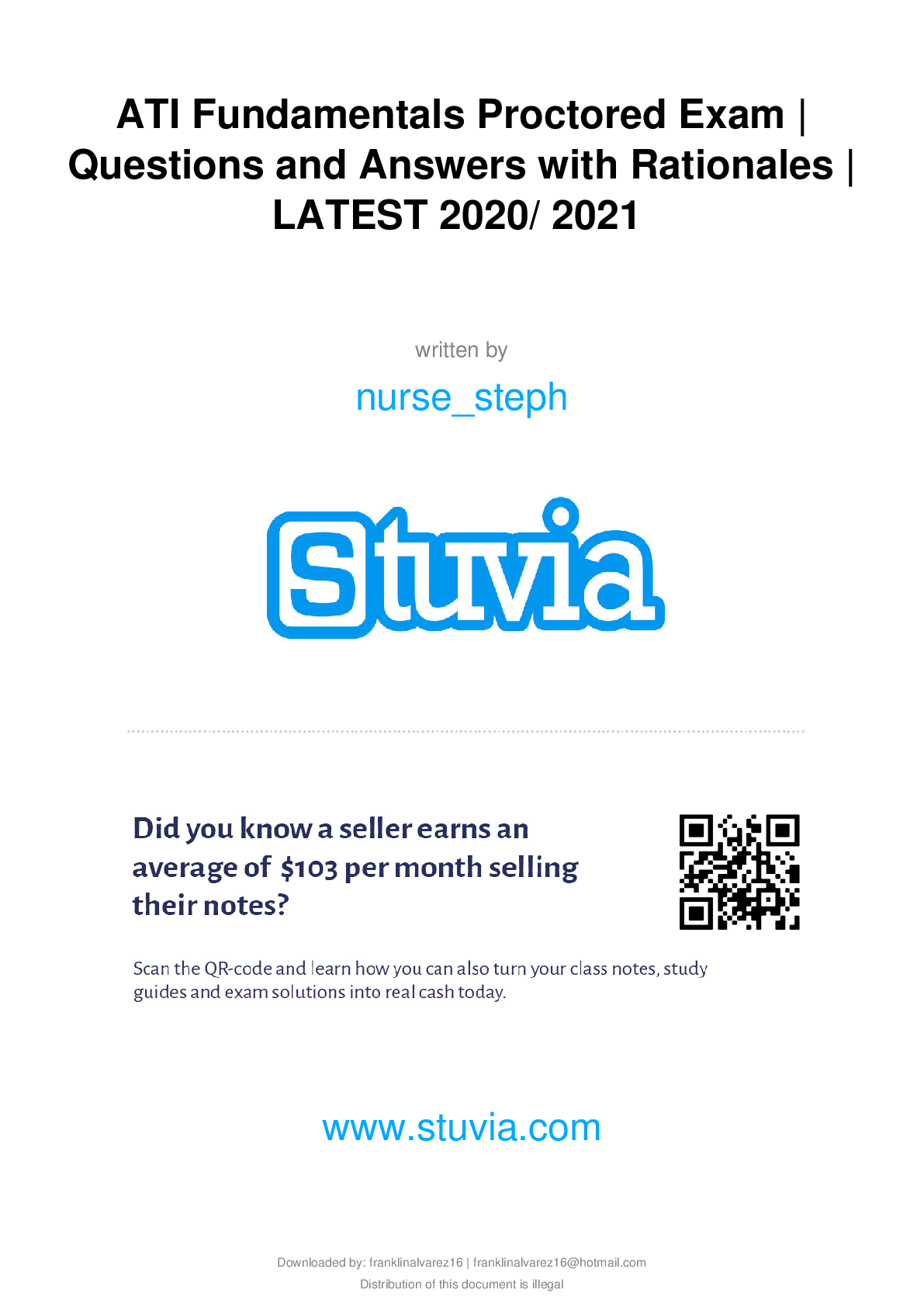
Buy this document to get the full access instantly
Instant Download Access after purchase
Add to cartInstant download
Reviews( 0 )
Document information
Connected school, study & course
About the document
Uploaded On
May 10, 2022
Number of pages
145
Written in
Additional information
This document has been written for:
Uploaded
May 10, 2022
Downloads
0
Views
74

